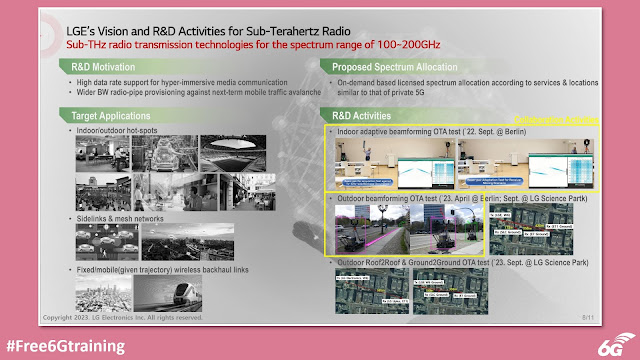Yesterday I blogged about the Videos & Presentations from Mobile Korea 2023. Over the next few weeks I will share some presentations I find interesting in this blog. We start with a presentation sharing LG's 6G global R&D collaboration activities.
One of the focus areas of 6G for LGE is the Sub-THz band. The Sub-THz band, as can be seen in the Tweet below, goes on from 100 GHz to 300 GHz. Since that band is still part of millimetre band, it is also often referred to as upper mmWave band.
Next G Alliance has a nice short report looking at 'Terminology for Frequency Ranges'. Handy and useful charts - https://t.co/kfJFxcdUDo via @atisupdates @NextGAlliance #Free5Gtraining #3G4G5G #ATIS #NGA #5G #B5G #6G #Frequency #Spectrum #Bands #mmWave #cmWave #THz pic.twitter.com/Nyoh1X0asX
— Free 5G Training (@5Gtraining) July 25, 2023
Fraunhofer HHI and LG announced their leadership in sub-THz band just last year. There were also announcements from LG on demo's in 6 THz band here and here.
At the 6G Global summit (part of Mobile Korea 2023), JaeHoon Chung from LG Electronics presented a talk on Global Collaborative R&D Activities for Advanced Radio Technologies.
As a part of the presentation, he introduced their 6G global R&D collaboration activities with Fraunhofer Heinrich Hertz Institute (HHI) in terms of Full Duplex Radio and Sub Terahertz Radio technologies. For Full Duplex Radio, the collaboration involves the establishment and leading of a global interest group activity to get technical consensus on use cases for advanced duplexing and relevant transceiver architecture also including technical promotion and standard proposals.
For Sub Terahertz Radio, the collaboration involves the exploratory R&D for Sub THz frontend devices and beamforming solutions, and their PoCs to resolve the challenges on the application for mobile communication.
The slides for the talk is available here and the video is embedded below:
In another news couple of months back, KT, LG Electronics, and Corning jointly announced the verification of RIS (Reconfigurable Intelligent Surface) performance for each 6G frequency candidate band. Their press release said:
The three companies verified RIS made with various samples such as glass, diode, and liquid crystal materials in the 8GHz and 15GHz bands of the FR3 band and the mmWave band, which are receiving attention as candidate 6G frequency bands. As a result of comparing the signal strength before and after applying RIS in hallways and offices with poor wireless communication quality, wireless communication performance improved for each frequency band from 4 times to 60 times.
In particular, the RIS in the 15GHz band is made of a transparent glass material that consumes no power, making it easy to apply to various environments within buildings, and the RIS in the 8GHz band is made of a semiconductor material, so the direction of incidence and reflection of radio waves can be adjusted in real time with a small amount of power.
Related Posts:


Comments
Post a Comment